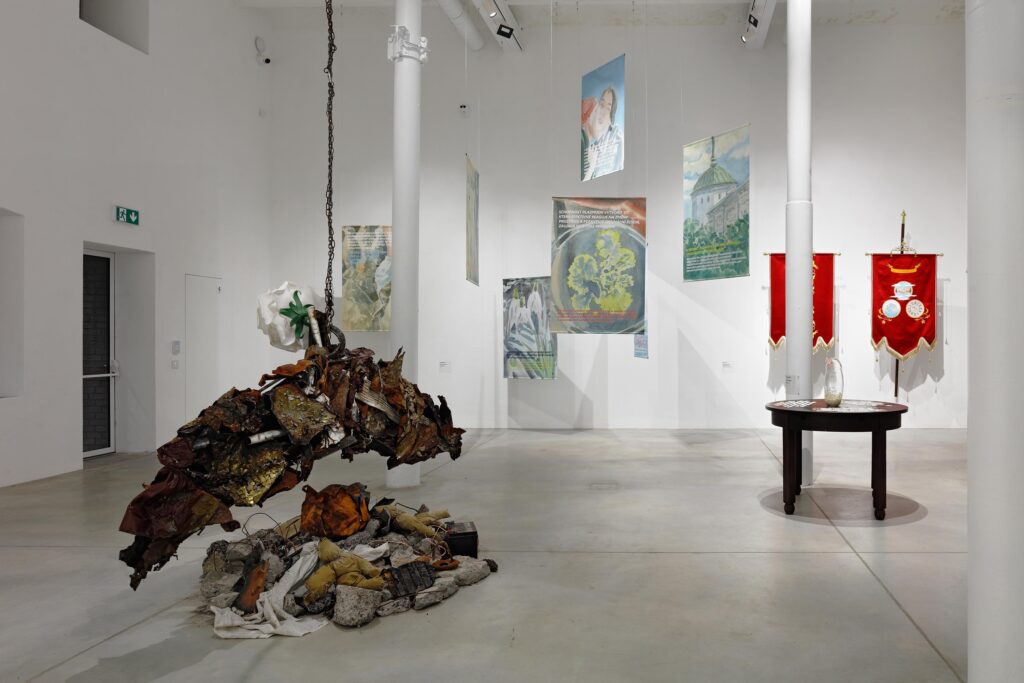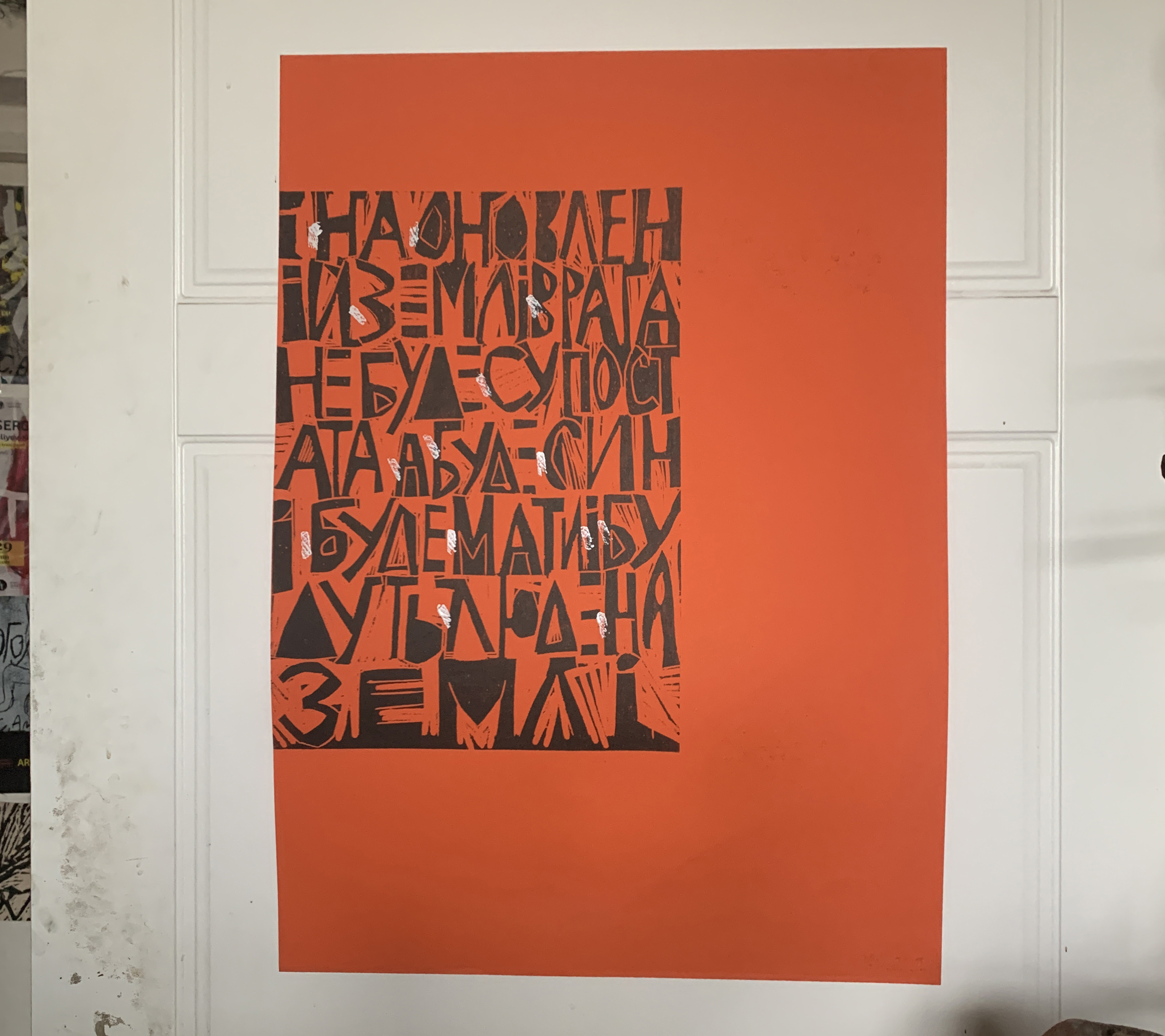On Renewed Land — Locating Ukrainian Destiny
A version of this essay was presented as part of text materials accompanying the exhibition Let the long. Road. Lead. To. Stairs in. The Heavens at PLATO Ostrava, CZ. The exhibition was produced in collaboration with Dnipro Center for Contemporary Culture, SONIAKH digest, Sunflower Solidarity Community Center in Warsaw. It was curated by Milena Khomchenko, Yulia Krivich, and Clemens Poole, together with Edith Jerabkova and Jakub Adamec, and features works by Beauty Studio, Bohdan Bunchak, Ksenia Hnylytska, Larion Lozovyi, Darija Lukjanenko, Sashko Protyah, Anna Sapon, Zhenia Stepanenko, Viktoriia Tymonova, as well as tarot readings of the works by the Ukrainian witch Frosiko.
The exhibition is on view at PLATO Ostrava from 8 February–16 April, 2023. Documentation and more information is available on PLATO's website. The exhibition is also scheduled to be shown at the Dnipro Center for Contemporary Culture in summer 2023.

FUTURE DURING WAR
Our team (Milena Khomchenko, Yulia Krivich, and myself) was first approached in September 2022 about curating an exhibition of contemporary Ukrainian art at PLATO Ostrava, in Ostrava, CZ. This proposition gave us pause. Following Russia’s full-scale invasion of Ukraine on February 24th, 2022, curatorial projects connected with Ukraine have had to cope with the double bind of addressing the constant developments of the ongoing extraterritorial state violence perpetrated by a neocolonial aggressor, while also justifying the very validity of artistic, curatorial, and cultural practices in the midst of such a cataclysm. Exhibition topics that are staples of contemporary discourse, and which have produced some of the most valuable reference points for curatorial practice, quickly become trivial in the face of shelling, torture, mass deportation, and the innumerable other war crimes committed daily in Ukraine by the Russian state.
How might one imagine an exhibition six months in the future, when plans for our own lives are impossible in that same timeframe? How can one address the theoretical, not to mention technical, needs of a project proposed for a moment in time that is obscured by the unpredictability of the present? In one particularly poignant conversation with a Ukrainian friend and writer on the topic of addressing the future in an exhibition context, she curtly responded: “Future? It’s bullshit. Right now there is no future.” Many others have echoed this sentiment, and I still find it difficult to disagree. As long as Russian rockets continue to rain down on Ukrainian lands, the future is dark. Despite this grim knowledge, this response should not be construed as overly pessimistic. While on the surface it appears to signal a certain nihilism (in which case it might be fully articulated as “there is no hope for the future”), her sentiment—and that of many Ukrainians—might be more accurately understood as a question of precognition (there is a future, but that future cannot be seen). It is this collective knowledge that Ukraine definitively does have a future, that led us to the notion of destiny as an anchor for our exhibition.
Ukrainians continue to live, and thrive, and resist, despite Russia’s most explicit attempts to erase them and their futures. Although I have to acknowledge that I have seen how despair cannot be fully banished from the minds of those affected by the war, it would be a gross misrepresentation to say that despair on the part of the Ukrainian people is a dominant feature of this war. On the contrary, hope, the antonym of despair, seems to rule the day. In this sense, while war makes the futures of those it affects elusive, the tenacity of Ukrainian hope speaks to a vision that cannot be eluded. What is more, we know that times of great uncertainty require vision for survival, and survival is the essence of all futures. The ideas of destiny that my Ukrainian colleagues and I brought together for our exhibition at PLATO Ostrava took many forms, but were, above all, visionary. These artistic works spoke to us precisely because they were not bound by the constraints of what was for us at the time an unseeable future—and what now continues to be a troubled present.
DESTINY DURING WAR
It is important to note that destiny is not always benign, and envisioning any nation that exists extratemporally cannot be an unqualified gesture. As any student of the ideological underpinnings of Russia’s colonial violence knows, destiny has long been present in its conversations about Ukraine. From foundational myths co-opting the history of the Kyivan Rus, to the ethno-essentialist fantasy of brotherly nations, Russian crimes have been predicated on the exploitation of a destiny-adjacent political will to power, in which Ukraine is both sacred heartland and alien to the point of total dehumanization. Any discussion of destiny during war must firmly reject the colonial degradation of the idea into manifest destiny, that unholy justifier of atrocities and imperialist aspirations.
Russia’s rhetorical use of these tropes is not coincidental. As argued by Timothy Snyder, the fascist evolution of the Russian state and its kleptocratic strongman Vladimir Putin is a direct expression of a political trajectory that is deeply inflected by temporal elements drawn from the same precognitive pool as our exhibition’s concept of destiny. Snyder’s politics of inevitability (as expressed in the socialism of the pre-Brezhnev Soviet Union) and politics of eternity (as expressed in the ahistorical embrace of fascism during Putin’s second round in office),[1] both seek to solve the problems of time and future in different ways, but both use a promise of something atemporal to lull adherents into a denial where blatant losses of freedom and quality of life are incompatible with a received reality constructed by the state. In the former, the Soviet utopian promise of fully achieved communism was the hollow beacon directing the repressive violence of the USSR’s politics of inevitability. In the latter, the victimhood and the mystical virgin innocence of the Russian people are the core of a destructive grievance politics that the Russian state uses to fill the void of its own failure as a political project. In both cases, time-based concepts adjacent to destiny (inevitability and eternity) wither the state and corrupt the society into complacency towards—or even celebration of—state violence.
Through our work on the exhibition, we understood that any current discussion of a Ukrainian destiny must acknowledge the perversity and corrupting power of these destiny-adjacent ideas, which have directly led to the genocidal invasion that has thrown the Ukrainian people’s struggle for survival into hyper-relief. This is itself an indignity, because in more peaceful circumstances, independent Ukraine’s state project has been about discovering the depth and breadth of Ukrainian identity as something not simply defined by external imperial and colonial forces. This decolonial undertaking, especially in culturally generative fields like contemporary art, has been carried out in historical conversation with, rather than dictated by, relationships with its neighbors. To draw on Snyder’s work again, defining the state through the identification of enemies is in fact the fascist root of current Russian politics. While Ukraine as a nation incorporates many political tendencies, as do all democratic units, it has continually defined itself most effectively through self-reflection and freedom of association, rather than fascistic negation. Ukraine is a complex and multifaceted sovereign nation. Ukraine is not defined by enmity towards what is external to it.
DESTINY AS A CONTAINER
The representation of Ukrainian destiny in Let the long. Road. Lead. To. Stairs in. The Heavens is intended to be endlessly generative. It is a destiny that populates the spaces of possible futures and pasts by capturing and articulating nodes of inspiration out of the boundless constellation of Ukraine’s artistic potentialities. If this sounds unmanageably cosmic, it is. When expressed in the format of this exhibition, however, we felt that the stubborn conundrum of defining Ukrainian destiny’s multifarious character came to have its own implications as an anti-fascist undertaking, in its opposition to the tyranny of linear and rational organization. In another discussion with Ukrainian friends during the coalescence of the exhibition’s concept, a suggestion arose that the temporary capture of these varied expressions might fit well into a container similar to the carrier bag of fiction described by Ursula K. Le Guin.[2] While our project affirms that Ukrainian destiny is no fiction, Le Guin’s formulation is helpful precisely because it pushes back on interpretive tendencies that our exhibition also hoped to overcome. Her ideas of narrative are decidedly (if not explicitly), anti-fascist. People, a multitude of gazes, experiences and intersecting paths constitute a narrative, replacing the violent tradition in which heroes, villains and conflicts tend to define a story—or, with unfortunate frequency, a history. This adversarial narrativization of the world, when viewed through Snyder’s lens, reveals itself as patently fascistic. Conversely, Le Guin’s carrier bag helps us decenter and emancipate the great narratives not only of fiction, but also of historical fact.
The metaphor of the carrier bag is also about the future. For the prehistoric proto-societies imagined by LeGuin, everything is of the moment—hunger, thirst, sun, rain, snow, cold, hot, strength, illness, love—until it is placed inside a container. The container transports this object into a future, and with that future, vision appears. Tomorrow has promise with a piece of food wrapped in a leaf, journeys can be undertaken with a tanned bladder filled with water, weather can be endured with warm clothes in a bundle, ailments can be cured with a medicine pouch or pot of ointment, sentiment can endure by tucking an object of devotion away for safekeeping, a future society can be built when cultural objects are preserved, and—vitally for our exhibition project—a destiny can be envisioned inside the container of a gallery’s walls. This should not be mistaken as materialism. As with Ukraine’s immaterial but palpable destiny, the essential element that most matters is not the thing itself, but the ideas born of the surety that tomorrow, there will be something, and that something spells survival. In this sense, all expressions of destiny that came to be part of the exhibition can be seen as microfacets of the greater will to live.
AND THERE WILL BE PEOPLE ON THE LAND
In this way, the temporal aspect of the exhibition was both concept and fundamental to its formation. During the development of the project, while we hoped that its ideas would specifically apply to the audience’s moment, we knew that in the highly volatile context of the war, that moment would remain unseeable for us, until it was literally upon us. Put more succinctly, the audience, by being present and viewing these works, became proof of the existence of precisely the future that we could not see—a future where Ukraine still exists, resists, and fights for survival. In this way, it became the responsibility of the audience to search for the shape of Ukrainian destiny in the works of artists who have made it their practice to persevere against the adversity of war, in spite of their own shrouded futures.
These ideas led us to one additional but integral curatorial gesture. In order to further structurally locate these futures, we commissioned the Ukrainian witch Frosiko to produce a series of tarot readings of each work, to stand in the place of conventional curatorial explanations. Although this commission had no specific guidelines, the texts ultimately reinforced the power, depth, and extratemporal connectivity of the pieces, both individually and in concert. What is more, the texts served as a medium not just for the voices of the exhibited objects, but for the voices of previous, and perhaps future, works of Ukrainian destiny. While this curatorial idea may have been unorthodox, we understood it as consistent with both the exhibition concept and context. The readings, titled Probability Lines, temporally position not just the works, but also the artists and the audience. As extratemporal predictions, they serve to liberate the works from being defined by only their temporal—and temporary—significance. This is not to say that the work of Ukrainian artists today should not be tied to the struggle of their nation against Russia’s malevolence. It is rather to say that there will be a day when these works are expressive of a peaceful (and victorious) reality, where aspects of their potentialities will be fact, just as the audience’s presence in the gallery today is expressive of a future that we, the curators could not see, but knew existed.
We believe that Frosiko’s contribution is part of a longer history in the Ukrainian artistic tradition, in which such sensitive, poetic, and predictive words are a medium that continues to flow through generations. As potentially destined proof of this fact, I offer a few closing words that speak to this greater continuity. On a recent visit to Dnipro, I encountered a fresh test print tacked to a door in the studio of Serhii Aliev-Kovyka, an artist who is active today in contemporary circles, but who hails from the last generation of artists to come of age in the Soviet Union. The linoleum-cut words emerge from a time when the boundaries of destiny and future may also have been in flux:

And on renewed land
There will be no enemy, no opponent,
And there will be a son, and there will be a mother,
And there will be people on the land.[3]
Penned by Taras Shevchenko more than a century and a half ago, this poetic vision may be separated from us by generations, political formations, and, tragically, much war and suffering, but, in the context of the exhibition’s larger conceptual thrust, it appears remarkably current. A Ukraine in which there will be “no enemy, no opponent”, is a Ukraine that is not defined by antagonisms, and as such, exists today in the anti-fascist and decolonial paths that inspire the exhibited artworks, as well as many other generative and forward-thinking artistic visions. The promise of the “son”, the “mother”, and the “people” exists in the container formed by the bodies and minds of the artists and the communities that will follow them. Lastly, as Ukrainian history has attested, renewal exists not just figuratively, but endlessly and irrepressibly, in the Ukraine that is now and that will be. In this artistic voice from generations past, together with the voices of the new generation gathered today at PLATO Ostrava, a Ukrainian destiny definitively exists.
Author's note: I would like to thank the many Ukrainian artists and writers whose influence is felt in this exhibition, and specifically Kateryna Iakovlenko, Lisa Biletska and Philip Olenyk, and Serhii Aliev-Kovyka for the conversations that shaped this text.
Clemens Poole is a US American artist living in Kyiv, Ukraine. His works have been presented variously in the US and Europe. Since 2014 his practice has been linked closely to the Ukrainian context. From 2014–19 he worked extensively with the art foundation IZOLYATSIA and has subsequently been active with a number of independent projects in Ukraine. He holds a BFA from the Cooper Union and an MA/MSc in international history from Columbia University and the London School of Economics. His work can be found online at clemenspoole.com
Published 11 March 2023
- Timothy Snyder, The Road to Unfreedom, 2018
- Ursula K. Le Guin’s essay “The Carrier Bag Theory of Fiction”, 1986
- From Taras Shevchenko, “Old Archimedes Drank No Wine”, 1860
